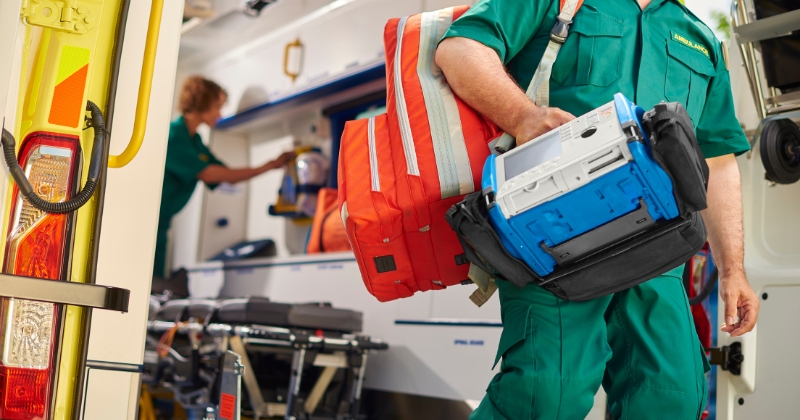When was the last time your health or life was threatened by your job?
Work-related fatalities occur every day despite companies’ best efforts to set strict safety standards and provide workers with adequate protective equipment.
Below, I’ll list some of the most dangerous jobs in Canada and their average wage.
If you’re considering working in one of these dangerous career fields, just make sure you’re prepared for potential injury and that the pay is worth it.
Most Common Work-Related Health And Safety Hazards
Whether you want to start a business or pursue a high-paying career, you’ll need to get comfortable with some level of inherent risk.
Every day that we get in our car and drive to work, we accept the risk of being involved in a vehicular accident. Every time we cross a busy city street, we take the risk of being struck by a car.
There’s no shortage of danger in life, and it can’t be avoided indefinitely. However, some jobs and careers are significantly more dangerous than others.
Here are some of the most common work-related health and safety hazards faced by workers in dangerous jobs:
- Falls: Occupations like roofers, construction workers, and electricians are frequently exposed to the risk of falling from significant heights
- Biological Hazards: First responders, along with healthcare and sanitation workers, are often exposed to bacteria, viruses, and other hazardous materials
- Chemical Exposure: Workers in chemical plants, miners, and some manufacturing jobs face hazards related to chemical exposure, which can lead to respiratory issues and, in some cases, chronic illnesses
- Heavy Machinery Accidents: Those involved in logging, construction, and agriculture often work around heavy machinery, presenting a risk of equipment-related accidents
- Electrocution: Electricians and power-line installers face the risk of electrocution, which can be fatal or lead to serious injuries
- Extreme Weather Conditions: Fishermen working in icy conditions and firefighters combating blazes deal with extreme environmental conditions, increasing their risk of hypothermia or heat-related illnesses
- Violence and Physical Harm: Police officers, healthcare workers in emergency departments, and similar professions are at risk of physical attacks
- Stress and Fatigue: Long-haul truck drivers and pilots who work extended hours are prone to stress and fatigue, which can lead to cognitive impairments, affecting their performance and safety
Interestingly, asbestos exposure is among the top work-related health and safety hazards. Over 500 Canadians die each year from asbestos-related illnesses (primarily cancer and mesothelioma).
Aside from Canadians who live in older homes with asbestos, many construction workers, roofers, home inspectors, and insulation specialists have been exposed to the once-common construction material and contracted serious illnesses from it.
“Life is either a daring adventure or nothing at all” – Helen Keller
The Most Dangerous Jobs In Canada (And How Much They Pay)

These are some of the most dangerous industries and careers in Canada, based on the likelihood of workplace fatalities, exposure to dangerous situations/chemicals, and injury. I’ve also included the latest salary data from Indeed Canada.
1. Logger/Arbhorist
- Average Salary: $44,155
- Primary dangers: Falling objects and dangerous equipment
The forestry industry involves the use of heavy machinery, chainsaws, and other potentially hazardous equipment. All of these pose substantial safety risks to workers, from general labourers to skilled arborists.
One of the most imminent threats is falling objects, such as branches or even entire trees, which can cause severe or fatal injuries.
The outdoor work environment, often in remote locations, adds another layer of complexity for immediate medical assistance in case of emergencies.
Overall, the combination of machinery, unpredictable natural elements, and isolation contribute to making logging a high-risk profession.
2. Construction Labourer
- Average Salary: $45,349
- Primary dangers: Heat exhaustion, falling, dangerous tools, muscular strain/injury
One of every five worker deaths in Canada are related to the construction industry, according to W. B. White Insurance, making this one of the most dangerous jobs in Canada by far.
Construction workers face numerous hazards, particularly when working on construction sites for large commercial buildings.
Power tools and heavy machinery, in particular, pose risks from cuts and lacerations to more severe injuries.
Additionally, the outdoor setting often exposes workers to the elements.
From heat exhaustion in the peak summer months to the potential for slip-and-fall accidents in winter ice storms, workers must remain vigilant at all times to prevent disaster on construction sites.
3. Powerline Technician
- Average Salary: $89,752
- Primary dangers: Electrocution, falling
Being a household electrician comes with its fair share of minor risks, such as electrocution from outlets or falling off of a ladder. However, power line workers face immense danger on a daily basis.
The electrical shock that can come from high-voltage power lines is so powerful that it can literally blow off your limbs.
These workers are paid very well for their work and are an essential part of maintaining daily electrical operations.
When severe winter storms knock down power lines, they’re the first to respond, often performing last-minute repairs in sub-zero temperatures so people like you and I can stay warm in our homes.
4. Police Officer
- Average Salary: $85,299
- Primary dangers: Violent attacks, motor vehicle incidents, exposure to hazardous materials
Police officers face a variety of risks in their daily jobs, including potential encounters with armed criminals, gun violence, high-speed chases, and domestic disputes that can escalate unpredictably.
Patrol officers often spend much of their day driving, which can increase their risk of being involved in a motor vehicle accident.
The constant threat of violence and the need for quick decision-making under stress make it a particularly dangerous job.
5. Firefighter
- Average Salary: $141,369
- Primary dangers: Falling, suffocation, severe burns
Fighting fires is one of the most dangerous industries in the world. Fire is an all-consuming force that even the best protective gear can’t always shield firefighters from.
Most firefighters start off as trained EMTs and can provide emergency medical response and fight fires.
When they rush into burning buildings to save people, they’re exposed to incredibly high temperatures, loose electrical lines, high-pressure steam, and smoke that contains potentially deadly fumes.
The training to become a firefighter is incredibly intense, and few make the cut. The ones who do are able to earn a very fair living, though.
6. Paramedic/EMT

- Average Salary: $64,653
- Primary dangers: Long hours/stress, PTSD, exposure to viruses and hazardous materials
Paramedics are medical professionals who are trained to respond to emergency calls and provide life-saving services.
Unfortunately, they’re not able to save everyone they help and often witness horrific accidents, which can lead to PTSD and trauma. A recent CBC report showed that one in four paramedics will develop PTSD at some point during or after their careers.
Additionally, they’re often called on to respond to patients who are under the influence of drugs/alcohol, who may respond with physical violence or expose them to biohazardous materials like old needles.
7. Commercial Fisher
- Average Salary: $62,890
- Primary dangers: Falling overboard, extreme weather, falling objects
Commercial fishing is a lot different from the leisure fishing that many Canadians enjoy on our lakes and rivers. It’s a hazardous job that requires absolute focus and the ability to remain calm in deadly seas.
Unpredictable weather combined with heavy machinery can quickly turn a routine outing into a life-threatening situation, making it a high-risk profession.
8. Mining Engineer
- Average Salary: $106,094
- Primary dangers: Hazardous gases, heavy equipment, tunnel collapse
A career as a mining engineer can be dangerous due to the risks associated with underground work, such as tunnel collapses and exposure to hazardous substances.
Heavy machinery operation and confined working conditions further elevate the risk of accidents.
Since miners often work deep underground in remote regions, it can take far longer for them to receive emergency care compared to those working topside or closer to larger cities and hospitals.
9. Farm Worker
- Average Salary: $41,552
- Primary dangers: Heavy machinery, chemical exposure, and animal-inflicted injuries
A job as a farm worker can be dangerous due to the use of heavy farm machinery, exposure to pesticides and other far chemicals, and the risk of animal-related injuries.
The outdoor work environment also poses challenges like heat exhaustion and dehydration.
10. Long-Haul Truck Driver
- Average Salary: $51,903
- Primary dangers: Stress/fatigue, vehicular accidents, back injury
Unlike regional truck drivers, who typically only drive within a few hours of home, long-haul truck drivers often spend days or weeks at a time on the road, transporting loads from one side of the country to the other.
The long hours driving can lead to high levels of stress and fatigue, which can result in falling asleep at the wheel and potential accidents.
Long-haul drivers must also drive through adverse weather conditions, which can become very dangerous, especially for large, fully-loaded tractor-trailers.
11. Commercial Diver
- Average Salary: $129,574
- Primary dangers: Drowning, hypoxia
A career as a commercial diver is not for the faint of heart. Even those who truly love diving and being underwater understand the risks associated with their daily career.
From drowning to decompression sickness and exposure to hazardous underwater conditions, situations can go downhill quickly.
The use of specialized equipment adds complexity and unforeseen issues like strong currents can quickly turn a dive into a dangerous situation.
12. Railroad Worker

- Average Salary: $62,400
- Primary dangers: Heavy equipment-related injuries
Railroad workers spend all day working in and around heavy machinery, coal cars, and other loading equipment.
There’s also the potential for collisions and handling hazardous materials. The job often involves working in close proximity to moving trains, and workers will need to be able to think fast to prevent accidents.
13. Agricultural Equipment Technician
- Average Salary: $122,777
- Primary dangers: Heavy equipment-related injuries, exposure to toxins
Agricultural equipment technicians perform repairs and equipment upgrades on heavy machinery and sharp tools. Risks include electrical hazards and exposure to toxic substances like pesticides and herbicides.
14. Roofer
- Average Salary: $58,687
- Primary dangers: Falling from heights
The most obvious risk of roofing is that you could fall from significant heights. Jobs often involve working on steep inclines and slippery surfaces, which can only increase the likelihood of accidents.
Although ropes and roofing systems alleviate some risks, they’re not always 100% foolproof.
15. Pipelayer
- Average Salary: $72,571
- Primary dangers: Tunnel collapse, electrocution
Pipelayers often work in deep tunnels and trenches, which could collapse, trapping workers underground.
Exposure to underground utilities like gas lines also elevates the risk of accidents. Pipelayers also frequently use heavy equipment, which comes with its own inherent risks.
16. Metal Worker
- Average Salary: $68,636
- Primary dangers: Heavy/sharp objects, sharp equipment, respiratory threats
Working as a metal worker poses various risks, including exposure to high temperatures, sharp edges, and heavy machinery.
Additionally, metal workers are often exposed to metal fumes and micro-particles of metallic dust that can pose a severe risk to the respiratory system.
17. Sanitation Worker
- Average Salary: $44,258
- Primary dangers: Hazardous waste, heavy equipment
A career as a sanitation worker can be dangerous due to exposure to hazardous waste, sewage, sharp objects, and potentially infectious materials.
The job often involves heavy lifting and operating machinery, increasing the risk of injuries. Traffic exposure while collecting waste adds another layer of risk.
18. Drilling Fluid Engineer
- Average Salary: $99,347
- Primary dangers: Pipeline blowouts, hazardous chemicals
Drilling fluid engineers face a high risk of explosions, fires, and exposure to hazardous chemicals.
While it’s their job to protect workers and try to prevent these worst-case scenarios, blowouts and accidents can occur, making this one of the most dangerous occupations in the energy sector.
Conclusion – Take Safety And Health Instruction Seriously
I’m not saying this to scare away any readers who are or plan on working in these fields. Many who work in these dangerous jobs have excellent careers, enjoy the work they do, and end up retiring with great benefits and no incidents.
That being said, you shouldn’t go into any career blindly, and certainly not for a paycheque alone.
No amount of money can buy back your health, so make sure that you’re taking all necessary precautions to minimize risks and contribute to a safer work environment for yourself and your team.
The good news is that you don’t have to work in a dangerous career to earn good money. Keep on reading to see my list of the best remote careers that allow you to earn up to six figures or more!





